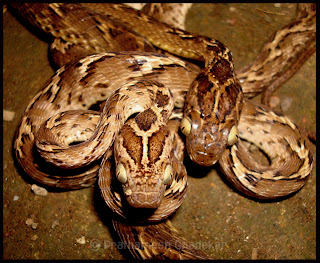This is a Checklist of Reptile Species found in Kulgaon-Badlapur Region, District : Thane, Maharashtra, India. (19' 9' 0" North : 73' 16' 0" East). I have been working with a group of interested individuals in this region for the past 10 years. The motive is conservation and Records of Reptile Species. This checklist is being updated to the best of our knowledge. Still there can be records which are not covered in this. Only confirmed records are being included and the checklist is tried to be kept precise.
SNAKES
1) Brahminy Worm Snake (Ramphotyphlops braminus)
Family : Typhlopidae
Status : Occasional
Type : Non-venomous
Length : Minimum : 35 mm
Adult : 125 mm
Maximim : 230 mm
Notes : A very small snake which looks similar to worm. It can be distinguished only by seeing the flickering tongue. Lives under the ground for most of the time and can therefore be an occasional sighting.
2) Beaked Worm Snake (Grypotyphlops acutus)
Family : Typhlopidae
Status : Occasional
Type : Non-venomous
_____________________________________________________________________
3) Indian Rock Python (Python molurus molurus)
Family : Pythonidae
Status : Uncommon
Length : Minimum : 500 mms
Adult : 3000 mms
Maximum : 7620 mms
Notes : The Indian Rock Python prefers to live in vast areas with least human disturbance. Found in Caves and Large Rock crevices when searched for. Mostly listed from Thick forested areas around the villages. More than one Pythons living at a same place and sharing the hiding is also seen.
1) Brahminy Worm Snake (Ramphotyphlops braminus)
Family : Typhlopidae
Status : Occasional
Type : Non-venomous
Length : Minimum : 35 mm
Adult : 125 mm
Maximim : 230 mm
Notes : A very small snake which looks similar to worm. It can be distinguished only by seeing the flickering tongue. Lives under the ground for most of the time and can therefore be an occasional sighting.
 |
| Ramphotyphlops braminus (Pic : Unmesh Barbhai, Jejuri) |
2) Beaked Worm Snake (Grypotyphlops acutus)
Family : Typhlopidae
Status : Occasional
Type : Non-venomous
Length : Maximum : 600 mm (24 inches) (2 feet)
Notes : A underground dweller. Larger than the Brahminy Worm Snake. Looks similar to a worm. Snout pointed like a beak. hence the name.
Notes : A underground dweller. Larger than the Brahminy Worm Snake. Looks similar to a worm. Snout pointed like a beak. hence the name.
 |
| Grypotyphlops acutus (Pic : Unmesh Barbhai, Jejuri) |
_____________________________________________________________________
3) Indian Rock Python (Python molurus molurus)
Family : Pythonidae
Status : Uncommon
Length : Minimum : 500 mms
Adult : 3000 mms
Maximum : 7620 mms
Notes : The Indian Rock Python prefers to live in vast areas with least human disturbance. Found in Caves and Large Rock crevices when searched for. Mostly listed from Thick forested areas around the villages. More than one Pythons living at a same place and sharing the hiding is also seen.
 |
| Python molurus molurus (Pic : Prathamesh Ghadekar) |
______________________________________________________________________
4) Common Sand Boa (Gongylophis conicus)
Family : Boidae
Status : Common
Length : Minimum : 125 mms
Adults : 500 mms
Maximum: 1000 mms
Notes : A common, stout and slow moving snake which is mostly mistaken as a Russel's Viper or a Python baby. In both the cases, it is killed because of the fear about the two snakes. A good burrower, it tends to avoid attention by moving very slowly and emerging mostly in the dark.
4) Common Sand Boa (Gongylophis conicus)
Family : Boidae
Status : Common
Length : Minimum : 125 mms
Adults : 500 mms
Maximum: 1000 mms
Notes : A common, stout and slow moving snake which is mostly mistaken as a Russel's Viper or a Python baby. In both the cases, it is killed because of the fear about the two snakes. A good burrower, it tends to avoid attention by moving very slowly and emerging mostly in the dark.
 |
| Gongylophis conicus (Pic : Prathamesh Ghadekar) |



